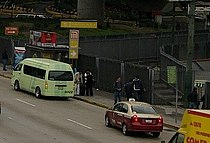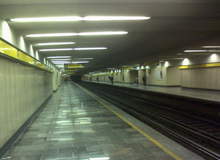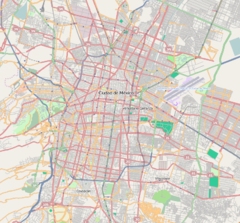| STC rapid transit | ||||||||||||||||||||||||||||||||||||||||||||||||||||||||||||||||||||||||||||||||||||||||||||||||||||||||||
 Station sign, 2006 Station sign, 2006 | ||||||||||||||||||||||||||||||||||||||||||||||||||||||||||||||||||||||||||||||||||||||||||||||||||||||||||
| General information | ||||||||||||||||||||||||||||||||||||||||||||||||||||||||||||||||||||||||||||||||||||||||||||||||||||||||||
| Location | Puerto Aéreo Boulevard Venustiano Carranza, Mexico City Mexico | |||||||||||||||||||||||||||||||||||||||||||||||||||||||||||||||||||||||||||||||||||||||||||||||||||||||||
| Coordinates | 19°26′01″N 99°05′16″W / 19.433734°N 99.087667°W / 19.433734; -99.087667 | |||||||||||||||||||||||||||||||||||||||||||||||||||||||||||||||||||||||||||||||||||||||||||||||||||||||||
| Owned by | Government of Mexico City | |||||||||||||||||||||||||||||||||||||||||||||||||||||||||||||||||||||||||||||||||||||||||||||||||||||||||
| Operated by | Sistema de Transporte Colectivo (STC) | |||||||||||||||||||||||||||||||||||||||||||||||||||||||||||||||||||||||||||||||||||||||||||||||||||||||||
| Line(s) | ||||||||||||||||||||||||||||||||||||||||||||||||||||||||||||||||||||||||||||||||||||||||||||||||||||||||||
| Platforms | 2 side platforms | |||||||||||||||||||||||||||||||||||||||||||||||||||||||||||||||||||||||||||||||||||||||||||||||||||||||||
| Tracks | 2 | |||||||||||||||||||||||||||||||||||||||||||||||||||||||||||||||||||||||||||||||||||||||||||||||||||||||||
| Connections |
| |||||||||||||||||||||||||||||||||||||||||||||||||||||||||||||||||||||||||||||||||||||||||||||||||||||||||
| Construction | ||||||||||||||||||||||||||||||||||||||||||||||||||||||||||||||||||||||||||||||||||||||||||||||||||||||||||
| Structure type | Underground | |||||||||||||||||||||||||||||||||||||||||||||||||||||||||||||||||||||||||||||||||||||||||||||||||||||||||
| Other information | ||||||||||||||||||||||||||||||||||||||||||||||||||||||||||||||||||||||||||||||||||||||||||||||||||||||||||
| Status | In service | |||||||||||||||||||||||||||||||||||||||||||||||||||||||||||||||||||||||||||||||||||||||||||||||||||||||||
| History | ||||||||||||||||||||||||||||||||||||||||||||||||||||||||||||||||||||||||||||||||||||||||||||||||||||||||||
| Opened | 19 December 1981 | |||||||||||||||||||||||||||||||||||||||||||||||||||||||||||||||||||||||||||||||||||||||||||||||||||||||||
| Passengers | ||||||||||||||||||||||||||||||||||||||||||||||||||||||||||||||||||||||||||||||||||||||||||||||||||||||||||
| 2023 | 5,718,207 | |||||||||||||||||||||||||||||||||||||||||||||||||||||||||||||||||||||||||||||||||||||||||||||||||||||||||
| Rank | 79/195 | |||||||||||||||||||||||||||||||||||||||||||||||||||||||||||||||||||||||||||||||||||||||||||||||||||||||||
| Services | ||||||||||||||||||||||||||||||||||||||||||||||||||||||||||||||||||||||||||||||||||||||||||||||||||||||||||
| ||||||||||||||||||||||||||||||||||||||||||||||||||||||||||||||||||||||||||||||||||||||||||||||||||||||||||
| ||||||||||||||||||||||||||||||||||||||||||||||||||||||||||||||||||||||||||||||||||||||||||||||||||||||||||
| ||||||||||||||||||||||||||||||||||||||||||||||||||||||||||||||||||||||||||||||||||||||||||||||||||||||||||
Terminal Aérea metro station is a Mexico City Metro station in Venustiano Carranza, Mexico City. It is an underground station with two side platforms, serving Line 5 (the Yellow Line), between Oceanía and Hangares stations. The station serves the Mexico City International Airport and the nearby colonias (neighborhoods) of Peñón de los Baños and Moctezuma 2ª sección along Boulevard Puerto Aéreo.
Terminal Aérea metro station opened on 19 December 1981, providing northwestward service toward Consulado metro station and eastward service toward Pantitlán metro station. The station's pictogram features an airliner and a control tower, reflecting its proximity to the airport's Terminal 1. Inside, there are six murals painted by David Lach. In 2019, the station had an average daily ridership of 18,389 passengers, ranking it the 96th busiest station in the network and the fourth busiest of the line.
Location and layout

Terminal Aérea is an underground metro station on Boulevard Puerto Aéreo, in Venustiano Carranza borough, in eastern Mexico City. It is located approximately 200 meters (660 ft) away from the entrance to the Gate A of the Terminal 1 at Mexico City International Airport.
Terminal Aérea metro station has two exits leading to Boulevard Puerto Aéreo, but none directly to the airport. The east exit is at the corner with Calle Aeropuerto Civil, in Colonia Peñón de los Baños, while the west entrance is found between Calle Norte 33 and Calle Oriente 33 in Colonia Moctezuma 2ª sección. On their Policy Review of Mexico, the OECD criticized the station for not having proper signage and for not being designed for first-time travelers as they "must negotiate over 110 steps" to reach it.
Within the system, the station lies between Oceanía and Hangares. The area is serviced by the Terminal 1 Metrobús station, belonging to Line 4, Line 4 (formerly Line G) of the trolleybus system, Routes 43 and 200 of the Red de Transporte de Pasajeros network, by Route 20-B of the city's public bus system, and the airport's people mover, Aerotrén.
History and construction

Line 5 of the Mexico City Metro was built by Cometro, a subsidiary of Empresas ICA. Its first section, where Terminal Aérea station is located, was opened on 19 December 1981, running from Pantitlán to Consulado stations.
Terminal Aérea metro station was built with Santo Tomás marble floors, travertine marble walls, and rustic-textured stucco plafond. The track between Oceanía and Terminal Aérea stations spans 1,174 meters (3,852 ft), and descends from the grade level to the underground level, with a 4.9% slope at the time of its opening. For the opposite section toward Hangares, which is 1,153 meters (3,783 ft) long, the tunnel was built with slurry walls using the Milan method.
Near the station, in Colonia Peñon de los Baños, workers found the remains of mammoths, bison, horses, camels, birds, and fishes, as well as a Teotihuacan settlement.
Name and pictogram
Before the station was built, Mexico City International Airport was serviced by the Aeropuerto station on Line 1 (the Pink line), located 15 blocks away to the south. After the Terminal Aérea metro station was constructed, many people continued to disembark at Aeropuerto station due to its confusing name and the station's airliner silhouette pictogram. It was not until 1997 that the station was renamed "Boulevard Puerto Aéreo", and the logo was updated to feature a logo of a bridge with a dome below, reflecting local landmarks. The pictogram for Terminal Aérea metro station depicts an airliner in front of a control tower instead.
Incidents
On 4 May 2015, a train crashed at Oceanía metro station when a train coming from Terminal Aérea crashed with another one parked at the end of the platforms. The crash was caused by a brake failure, coupled with heavy rain and hail. Terminal Aérea station was temporarily closed for repairs after the crash.
Since 1981, subsidence caused by rain had increased the slope between both stations to at least 7%. To address the sinkings, a 1 km (0.62 mi) tunnel extension was planned but canceled due to budget constrains. Instead, an 800 m (0.50 mi) anti-rain roof that cost Mx$65 million was built to prevent the tracks from getting wet and reduce the risk of trains sliding.
From 1 to 16 March 2020, Terminal Aérea, Hangares, and Pantitlán stations were closed due to a gasoline leak at a surface petrol station.
Ridership
According to the data provided by the authorities, before the impact of the COVID-19 pandemic on public transport, commuters averaged per year between 15,700 and 18,400 daily entrances between 2014 and 2019; the station had a ridership of 6,712,062 passengers (18,389 passengers per day) passengers in 2019, marking an increase of 74,719 passengers compared to 2018. In 2019 specifically, Terminal Aérea metro station ranked as the 96th busiest of the system's 195 stations and the line's fourth busiest.
| Annual passenger ridership | |||||
|---|---|---|---|---|---|
| Year | Ridership | Average daily | Rank | % change | Ref. |
| 2023 | 5,718,207 | 15,666 | 79/195 | −0.15% | |
| 2022 | 5,727,082 | 15,690 | 69/195 | +29.58% | |
| 2021 | 4,419,693 | 12,108 | 64/195 | +12.09% | |
| 2020 | 3,943,045 | 10,773 | 92/195 | −41.25% | |
| 2019 | 6,712,062 | 18,389 | 96/195 | +1.13% | |
| 2018 | 6,637,343 | 18,184 | 100/195 | +5.65% | |
| 2017 | 6,282,484 | 17,212 | 105/195 | +2.70% | |
| 2016 | 6,117,190 | 16,713 | 108/195 | +3.03% | |
| 2015 | 5,937,008 | 16,265 | 106/195 | +3.53% | |
| 2014 | 5,734,509 | 15,710 | 108/195 | +3.57% | |
| Historical annual passenger ridership | |||||
| 2009 | 4,905,984 | 13,441 | 111/175 | — | |
Landmarks
Terminal Aérea station has six murals painted by Mexican artist David Lach in 1981, becoming the first person to do it inside the Mexico City Metro. Four murals, titled Paisajes cálidos y fríos, are located on the platform's headwalls, with Cálidos on the southern walls and Fríos on the northern walls. According to Lach, the red and green colors represent direction and temperature. The other two murals, Tlaltilco (in the east lobby) and Cuitzeo (in the west lobby), blend elements of pre-Columbian culture with contemporary Mexican imagery.
Near the station, a pedestrian bridge known as "MacPuente" is used as an informal observation deck where people gather to watch airplanes land and take off.
Gallery
Murals by David Lach Cuitzeo, in honor of pre-Hispanic cultures
Cuitzeo, in honor of pre-Hispanic cultures Tlatilco, in honor of pre-Hispanic cultures
Tlatilco, in honor of pre-Hispanic cultures One of the Paisajes Cálidos
One of the Paisajes Cálidos One of the Paisajes FríosThere are multiple murals inside Terminal Aérea station.
One of the Paisajes FríosThere are multiple murals inside Terminal Aérea station.
Notes
- Estación del Metro Terminal Aérea. Spanish pronunciation: [teɾmiˈnal aˈe.ɾea] . The name of the station literally means "Air Terminal" in Spanish and it is known in English as Air Terminal station.
References
- ^ "Afluencia de estación por línea (2022–2023)" [Station traffic by line (2022–2023)] (in Spanish). Sistema Transporte Colectivo Metro. 2024. Archived from the original on 27 January 2024. Retrieved 24 January 2024.
- Sultana, Selima; Weber, Joe (2016). Minicars, Maglevs, and Mopeds: Modern Modes of Transportation Around the World. Santa Barbara, California: ABC-CLIO. p. 194. ISBN 978-1-4408-3494-3.
- "Metro". Mexico City International Airport. 25 July 2017. Archived from the original on 9 July 2017. Retrieved 15 April 2020.
- ^ "Línea 5, Ciudad de México" [Line 5, Mexico City] (in Spanish). iNGENET Infraestructura. 20 July 2009. Archived from the original on 2 September 2014. Retrieved 15 April 2020.
- Baird, David; Cristiano, Juan; Bairstow, Lynne (2007). Frommer's Mexico 2008. New York City: John Wiley & Son. p. 90. ISBN 9780470145746.
- Harvard Student Agencies (1995). Hale-Wehmann, Kenneth (ed.). "Let's Go: The Budget Guide to Mexico". Let's Go!. New York City: St. Martin's Press: 60. ISSN 0884-6529. OCLC 11735368.
- ^ "Terminal Aérea" (in Spanish). Sistema de Transporte Colectivo Metro. Archived from the original on 8 August 2011. Retrieved 15 April 2020.
- OECD (2017). OECD Studies on Tourism: Tourism Policy Review of Mexico. Paris, France: OECD. p. 105. ISBN 978-92-64-26657-5.
- "Red de Rutas" [Routes network] (in Spanish). Red de Transporte de Pasajeros. Retrieved 30 October 2021.
- "Red de corredores" [Route network]. Organismo Regulador de Transporte (in Spanish). Archived from the original on 14 October 2021. Retrieved 30 October 2021.
- "Aerotren". Mexico City International Airport. Archived from the original on 25 February 2021. Retrieved 30 October 2021.
- "Baia, Baia, Tacubaya... Las estaciones del metro MÁS y MENOS utilizadas en CDMX" [Well, well, well... The MOST and LEAST used stations in Mexico City] (in Spanish). Nación 321. 4 September 2019. Archived from the original on 15 April 2020. Retrieved 14 April 2020.
- ^ "Longitud de estación a estación por línea" [Length from station to station by line] (in Spanish). Sistema de Transporte Colectivo Metro. Archived from the original on 4 May 2021. Retrieved 12 July 2021.
- "Plan Maestro del Metro 2018 – 2030" [Master Plan 2018 – 2030] (PDF) (in Spanish). Sistema de Transporte Colectivo Metro. 2018. p. 59. Archived (PDF) from the original on 17 December 2019.
- Gamez Rojas, Marlen (2010). "Análisis de riesgos de incendio en el Sistema de Transporte Colectivo Metro" [Fire Risk Analysis in the Sistema Transporte Colectivo Metro] (PDF) (in Spanish). Escuela Superior de Ingeniería Mecánica y Eléctrica. Instituto Politécnico Nacional. p. 94. Archived from the original (PDF) on 23 November 2020.
- Sánchez Vázquez, Ma. de Jesús; Mena Cruz, Alberto; Carballal Staedtler, Margarita (2010). "Investigación Arqueológica en la Construcción del Metro" [Archaeological Research in the Construction of the Metro] (PDF) (in Spanish). Mexico City: Instituto Nacional de Antropología e Historia. Archived (PDF) from the original on 9 July 2020. Retrieved 9 July 2020.
- Asociación del Congreso Panamericano de Ferrocarriles (1975). Boletín de la Comisión Permanente [Newsletter of the Permanent Commission] (in Spanish). Vol. 58. p. 154.
- Noble, John; Bernhardson, Wayne (1995). Mexico (5 ed.). Hawthorn, Victoria: Lonely Planet. p. 219. ISBN 0864422911.
- Wood, Andrew G. (2003). Pilcher, Jeffrey M. (ed.). The Human Tradition in Mexico. Wilmington, Delaware: SR Books. p. 185. ISBN 0-8420-2975-3.
- Santos Gallagher, Hugo (14 July 2017). "¿Por qué algunas estaciones del Metro cambiaron de nombre?" [Why the names of some stations were changed?]. El Universal (in Spanish). Archived from the original on 5 August 2018. Retrieved 16 April 2020.
- ^ Pazos, Francisco (27 July 2016). "Techumbre antilluvia alcanza 45% de avance de la Línea 5: Terminal Aérea y Oceanía" [The Anti-rain Roof on Line 5 has Reached 45% Progress Between Terminal Aérea and Oceanía Stations]. Excélsior (in Spanish). Archived from the original on 27 May 2020. Retrieved 26 May 2020.
- Alarcón, Rodrigo (5 May 2015). "RTP brindará traslado gratuito de Pantitlán a Eduardo Molina" [Red de Transporte de Pasajeros will provide free service from Pantitlán to Eduardo Molina]. Excélsior. Archived from the original on 30 October 2017. Retrieved 23 August 2020.
- Kornei, Katherine (20 December 2017). "Sinking of Mexico City linked to metro accident, with more to come". Science. Archived from the original on 14 January 2020. Retrieved 15 April 2020.
- Valdez, Ilich (13 December 2016). "Concluyen obra en L5 del Metro para evitar accidentes" [The Work on Line 5 of the Metro Has Been Completed to Prevent Accidents]. Milenio (in Spanish). Archived from the original on 30 May 2021. Retrieved 30 May 2021.
- "Reabren estaciones de L5 del Metro cerradas por fuga de gasolina" [Reopened the Metro L5's station closed by a gasoline leak]. Milenio (in Spanish). 17 March 2017. Archived from the original on 18 March 2020. Retrieved 15 April 2020.
- ^ "Afluencia de estación por línea 2019" [Station traffic by line in 2019] (in Spanish). Sistema Transporte Colectivo Metro. 2020. Archived from the original on 3 July 2020. Retrieved 3 May 2020.
- ^ "Afluencia de estación por línea 2018" [Station traffic by line in 2018] (in Spanish). Sistema Transporte Colectivo Metro. 2019. Archived from the original on 6 June 2019. Retrieved 7 April 2020.
- "Afluencia de estación por línea 2021" [Station traffic by line in 2021] (in Spanish). Sistema Transporte Colectivo Metro. 2022. Archived from the original on 7 March 2022. Retrieved 7 March 2022.
- "Afluencia de estación por línea 2020" [Station traffic by line in 2020] (in Spanish). Sistema Transporte Colectivo Metro. 2021. Archived from the original on 21 June 2021. Retrieved 21 June 2021.
- "Afluencia de estación por línea 2017" [Station traffic by line in 2017] (in Spanish). Sistema Transporte Colectivo Metro. 2019. Archived from the original on 3 May 2020. Retrieved 3 May 2020.
- "Afluencia de estación por línea 2016" [Station traffic by line in 2016] (in Spanish). Sistema Transporte Colectivo Metro. 2017. Archived from the original on 3 May 2020. Retrieved 3 May 2020.
- "Afluencia de estación por línea 2015" [Station traffic by line in 2015] (in Spanish). Sistema Transporte Colectivo Metro. 2016. Archived from the original on 3 May 2020. Retrieved 6 May 2020.
- "Afluencia de estación por línea 2014" [Station traffic by line in 2014] (in Spanish). Sistema Transporte Colectivo Metro. 2015. Archived from the original on 3 May 2020. Retrieved 6 May 2020.
- "Afluencia de estación por línea 2009" [Station traffic by line in 2009] (in Spanish). Sistema Transporte Colectivo Metro. 2010. Archived from the original on 7 September 2010. Retrieved 20 December 2024.
- ^ "Un verano para disfrutar los murales expuestos en estaciones del Metro" [A Summer to Enjoy the Murals Displayed in Metro Stations] (in Spanish). Radio Fórmula. 21 July 2012. Archived from the original on 15 April 2020. Retrieved 15 April 2020.
- ^ "Primer periodo ordinario de sesiones del segundo año de ejercicio" [First ordinary session of the second year of activities] (PDF) (in Spanish). Legislative Assembly of Mexico City. 25 July 2007. p. 40. Archived (PDF) from the original on 18 July 2014. Retrieved 15 April 2020.
- "Paisajes cálidos y fríos" [Warm and Cold Landscapes] (in Spanish). Sistema Transporte Colectivo Metro. Archived from the original on 24 December 2017. Retrieved 15 April 2020.
- Bialostozky, Héctor (28 August 2019). "MacPuente: el puente peatonal en el Aeropuerto que se usa como mirador de aviones" [MacPuente: The Pedestrian Bridge at the Airport, Commonly Used as an Aircraft Observation Deck] (in Spanish). Local.mx. Archived from the original on 15 April 2020. Retrieved 15 April 2020.
- De Anda, Tamara (14 December 2017). "Excéntrica CDMX – Vuela, vuela" [Eccentric Mexico City – Fly, fly] (in Spanish). máspormás. Archived from the original on 15 December 2017. Retrieved 16 April 2020.
External links
 Media related to Estación Terminal Aérea (Metro de México) at Wikimedia Commons
Media related to Estación Terminal Aérea (Metro de México) at Wikimedia Commons- "Metro Terminal Aérea". At the Official Guide to Mexico City.
| Venustiano Carranza, Mexico City | |
|---|---|
| Areas | |
| Schools |
|
| Mexico City Metro stations | |
| Landmarks | |
